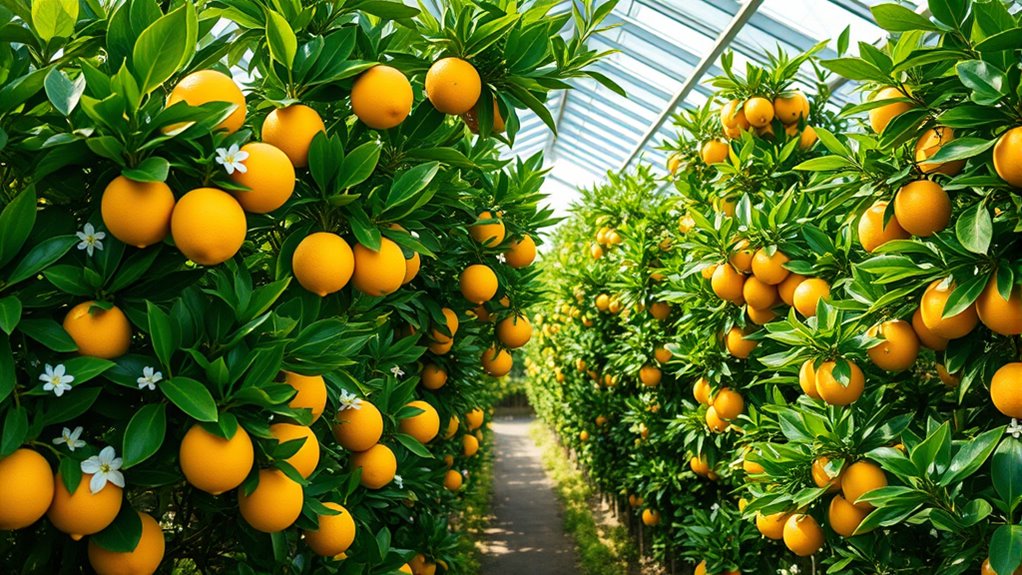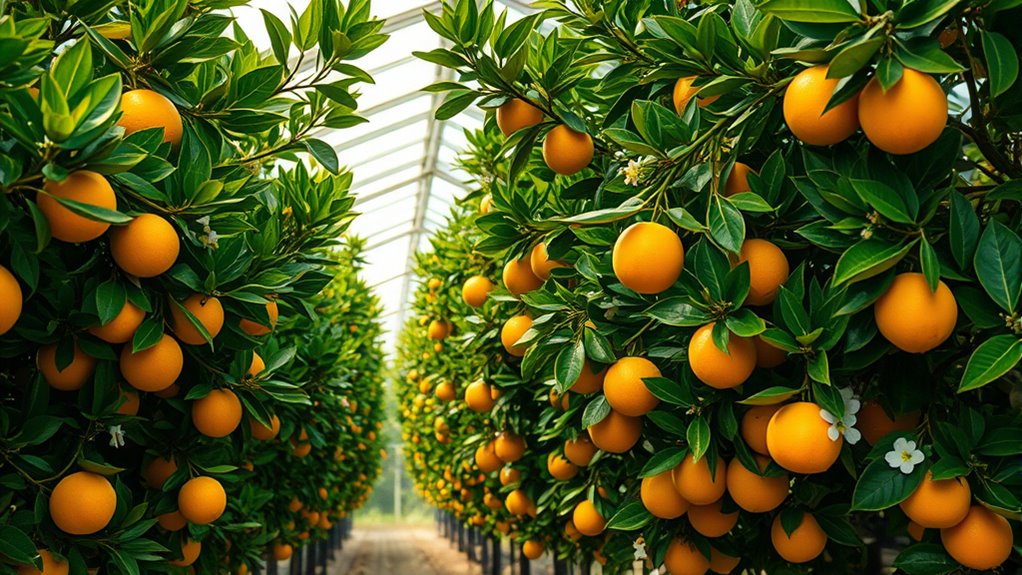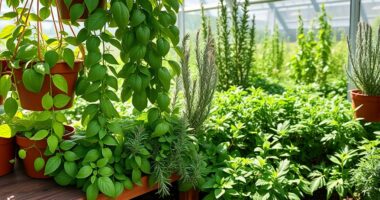Growing citrus trees in greenhouses lets you enjoy fresh lemons, oranges, and more all year round, regardless of your climate. By controlling temperature, humidity, and ventilation, you create ideal conditions for healthy growth and bountiful harvests. Regular pruning and pest management help keep your trees strong and productive, while environment controls reduce pest risks. Keep exploring to discover how to optimize your greenhouse setup and keep your citrus thriving season after season.
Key Takeaways
- Greenhouses provide a controlled environment for year-round citrus cultivation, ensuring consistent fruit production regardless of external weather.
- Proper pruning and environmental management promote healthy growth, improve air circulation, and enhance fruit quality on citrus trees.
- Regular pest inspections and organic control methods help maintain healthy citrus trees and prevent pest infestations.
- Managing humidity, ventilation, and spacing reduces fungal and pest-related issues in greenhouse citrus cultivation.
- Integrating pruning, pest management, and environmental controls optimizes growth and fruit yield of lemons, oranges, and other citrus varieties.

Growing citrus trees in greenhouses offers a controlled environment that allows you to enjoy fresh, juicy fruits year-round, regardless of your local climate. With the right care, your citrus trees can thrive indoors, producing abundant harvests of lemons, oranges, and other favorites. One of the key aspects of maintaining healthy citrus trees is mastering pruning techniques. Regular pruning helps shape your trees, improve air circulation, and remove dead or diseased branches. When pruning, make clean cuts just above a healthy bud or branch to encourage new growth. Focus on thinning out crowded areas to prevent fungal issues and pests from taking hold. Proper pruning also ensures sunlight reaches all parts of the tree, boosting fruit production and quality.
Pest management is equally essential when growing citrus in a greenhouse. Unlike outdoor environments, a greenhouse can sometimes create a perfect habitat for pests if not carefully monitored. Common pests include aphids, scale insects, and spider mites, which can weaken your trees and spread diseases. To keep these pests in check, start with regular inspections—look under leaves and around branches. Introducing natural predators, like ladybugs, can help control pest populations without chemical interventions. Additionally, using organic insecticidal soaps or neem oil can be effective, especially when applied early. Maintaining a clean greenhouse environment—removing fallen leaves and debris—reduces pest hiding spots and minimizes infestation risks. A good understanding of greenhouse environments helps optimize conditions for citrus growth while minimizing pest issues.
Controlling humidity and airflow inside the greenhouse also plays a critical role in pest management. Too much humidity encourages fungal diseases, which can make your trees more vulnerable to pests. Ventilation systems, fans, and proper spacing between trees allow fresh air to circulate, reducing the likelihood of fungal and pest problems. If you notice signs of pests or disease, address the issue promptly. Isolating affected trees prevents pests from spreading to healthy plants. Combining vigilant pest management with strategic pruning ensures your citrus trees stay healthy and productive.
Frequently Asked Questions
How Do I Prevent Pests on Greenhouse Citrus Trees?
To prevent pests on your greenhouse citrus trees, regularly inspect your plants for signs of infestation. Use biological pest control methods, like introducing beneficial insects, to naturally keep pests at bay. When needed, apply organic pesticides that are safe for your trees and the environment. Maintaining proper hygiene, avoiding overwatering, and ensuring good airflow also help reduce pest problems, keeping your citrus healthy and productive.
What Are the Ideal Humidity Levels for Citrus in Greenhouses?
You should aim for humidity control between 50-60% to keep your citrus healthy. Maintaining this moisture level helps prevent issues like leaf drop and disease. Use a humidifier or misting system if the air gets too dry, especially in winter. Keep an eye on moisture levels regularly with a hygrometer, and adapt your greenhouse environment as needed to ensure your citrus trees thrive without stress.
Can Citrus Trees Be Grown Indoors Without a Greenhouse?
Yes, you can grow indoor citrus trees without a greenhouse. Use container planting to easily move your citrus indoors during colder months. Make certain your indoor citrus gets plenty of sunlight—at least 8 hours daily—and maintain proper humidity levels. Regular watering and occasional fertilization support healthy growth. With the right care, indoor citrus trees can thrive in your home, providing fresh fruit and a lovely decorative touch.
How Often Should I Fertilize My Greenhouse Citrus Trees?
Think of your citrus trees like a well-tuned orchestra—they need the right fertilizer schedule to perform at their best. Fertilize every 4-6 weeks during active growth with a balanced, citrus-specific fertilizer. Adjust frequency if you notice nutrient deficiencies, such as yellowing leaves or poor fruiting. Consistent feeding keeps your trees healthy, vibrant, and fruit-bearing, ensuring they don’t miss a beat in your greenhouse symphony.
What Are Common Signs of Citrus Tree Diseases?
You’ll notice citrus tree diseases through symptoms like citrus leaf spots, which appear as dark or yellow patches on leaves, and fruit blemishes, such as cracks or discoloration. Watch for leaf drop, unusual spots, or mold, as these indicate potential issues. Regularly inspecting your trees helps catch problems early, allowing you to treat infections promptly and keep your citrus healthy.
Conclusion
Just as Icarus soared toward the sun with hope and ambition, you can nurture your citrus dreams in a greenhouse. With patience and care, you’ll watch your lemons, oranges, and more flourish, bringing a touch of sunshine indoors. Remember, every great orchard starts with a single seed—so keep tending yours. Soon, you’ll enjoy the sweet reward of your efforts, feeling like the master of your own citrus paradise, just like a modern-day Daedalus crafting his haven.









